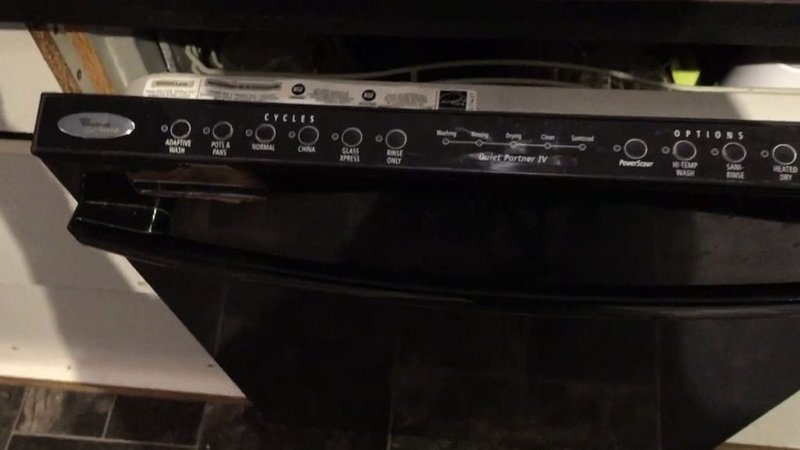
The F1 error code in a KitchenAid dishwasher typically points to a problem related to water supply issues. Think of it as a warning light in your car telling you something’s off under the hood. Maybe there’s a kink in the hose or a glitch in the system. Don’t worry; just like you don’t need to be a mechanic to fix minor car issues, you don’t need to be an appliance expert to reset your dishwasher. I’m here to guide you through the process in plain, easy-to-understand language. So, roll up your sleeves, and let’s get those dishes back on track!
Understanding the F1 Error Code
Before we jump into fixing things, let’s break down what this pesky error code actually means. When your KitchenAid dishwasher flashes the F1 error, it’s essentially trying to tell you there’s a hiccup in the water system. Imagine trying to drink from a water fountain when the pressure’s too low or too high; it’s just not going to work smoothly. Similarly, your dishwasher might be struggling with water flow, causing the system to alert you with this error.
The root cause could be something as simple as a water inlet valve issue. Picture the valve as a door that regulates the amount of water entering the dishwasher. When it’s not opening or closing properly, your dishwasher won’t get the right amount of water, which could trigger the F1 error. Alternatively, it might be a kinked hose or a clogged water path that’s messing up the pressure balance. Both scenarios are pretty common and definitely fixable.
Once you know what the F1 code is trying to communicate, you’re in a much better position to address it. It’s like understanding the symptoms of a cold before reaching for the cough syrup. So now that we’ve decoded the message, let’s tackle how to reset your dishwasher and get it back in working order.
Resetting Your KitchenAid Dishwasher
Alright, let’s get into the nitty-gritty of resetting your dishwasher. First things first—resetting isn’t just hitting a button. It’s more of a process, much like rebooting your computer. To start, ensure that there’s no ongoing cycle. This is crucial because you wouldn’t want to halt a running machine abruptly. Think of it as waiting for your blender to stop whirring before checking its blades.
Next, head over to your dishwasher’s main power source. You’re going to unplug it. Yes, like turning off and on your phone when it starts acting up. If unplugging seems too daunting due to the plug’s location, switch off the power from your circuit breaker. This step allows the dishwasher to reset its internal electronic components fully, much like clearing your head after a good nap.
Once the power is off, wait for about 5 minutes. I know, patience isn’t our strongest suit these days, but this waiting period allows the machine’s memory to wipe clean of any glitches. Afterward, plug your dishwasher back in (or switch the breaker back on) and give it a test run. Chances are, the F1 error might have disappeared, and your dishwasher’s ready to conquer those dirty plates.
Checking for Ongoing Issues
So, you’ve reset your dishwasher, and everything seems hunky-dory. But what if the F1 error keeps popping up? Let’s explore some potential culprits that might be lurking around. First, let’s check the water inlet valve we talked about earlier. If it’s malfunctioning, it’s like having a blocked straw when you’re trying to sip on a smoothie. The solution might involve either cleaning or even replacing the valve if it’s too worn out.
Another suspect could be the water hose. Over time, these hoses can become kinked or blocked, disrupting the water flow much like a garden hose that suddenly stops delivering water. Inspect the hose for any blockages and make sure it’s securely connected with no bends or twists. Straightening out a kinked hose is a quick and easy fix, much like untangling a piece of string.
And hey, don’t overlook the filters at the bottom of your dishwasher. Sometimes, debris can clog these filters, preventing proper drainage and misleading the system to signal an F1 error. Cleaning these filters regularly can not only fix the problem but also extend the life of your dishwasher in the long run.
Preventing Future Errors
Now that you’ve wrestled with your F1 error and come out victorious, let’s talk about keeping it at bay in the future. Prevention, as they say, is better than cure. For starters, regularly check the water connections and hoses for any signs of wear and tear. Imagine it as checking your tires before a long road trip; it just makes sense to prevent breakdowns.
Also, consider running an empty cycle with a dishwasher cleaner once a month. This helps in maintaining the internal components, ensuring that blockages and mineral build-ups are kept at a minimum. It’s like giving your appliance a spa day—keeping it refreshed and in top shape.
Lastly, always make sure to load your dishwasher correctly. Overloading can lead to improper cleaning and excessive strain on the machine’s components, much like trying to stuff a suitcase until it can barely zip. Following these simple tips can help you say goodbye to that pesky F1 error for good.
And there you have it! Resetting your KitchenAid dishwasher after encountering that F1 error is not as daunting as it might seem. With a little patience and these handy tips, you’ll have your dishwasher back to its prime in no time.